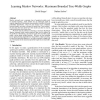Free Online Productivity Tools
i2Speak
i2Symbol
i2OCR
iTex2Img
iWeb2Print
iWeb2Shot
i2Type
iPdf2Split
iPdf2Merge
i2Bopomofo
i2Arabic
i2Style
i2Image
i2PDF
iLatex2Rtf
Sci2ools
SODA
2001
ACM
2001
ACM
Learning Markov networks: maximum bounded tree-width graphs
Markov networks are a common class of graphical models used in machine learning. Such models use an undirected graph to capture dependency information among random variables in a joint probability distribution. Once one has chosen to use a Markov network model, one aims to choose the model that "best explains" the data that has been observed--this model can then be used to make predictions about future data. We show that the problem of learning a maximum likelihood Markov network given certain observed data can be reduced to the problem of identifying a maximum weight low-treewidth graph under a given input weight function. We give the first constant factor approximation algorithm for this problem. More precisely, for any fixed treewidth objective k, we find a treewidth-k graph with an f(k) fraction of the maximum possible weight of any treewidthk graph.
Related Content
| Added | 31 Oct 2010 |
| Updated | 31 Oct 2010 |
| Type | Conference |
| Year | 2001 |
| Where | SODA |
| Authors | David R. Karger, Nathan Srebro |
Comments (0)

